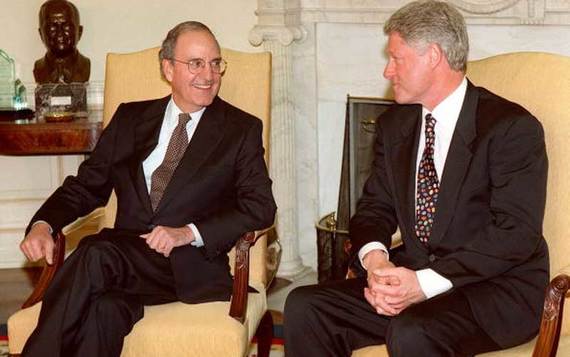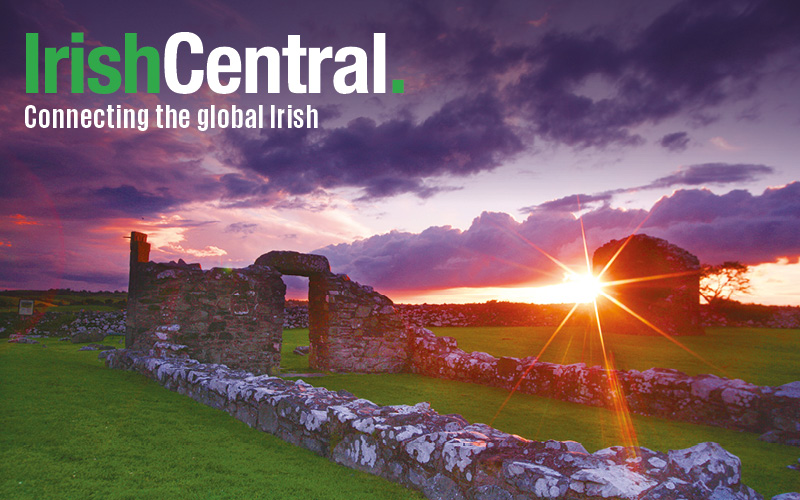Vice-President Joe Biden will be at our Embassy residence this week for an American launch of the new "Cambridge History of Ireland," a major four-volume work that charts Ireland's story from the year 600 to the present.
This publication traces Ireland’s development from the time when Ireland was an outpost of Christian civilization in Europe, through the Viking era, the arrival of the Normans and tribulations of Anglo-Irish relations in the centuries that followed.
As a historian of the 19th and 20th centuries, I was especially interested in its analysis of the century-long efforts to undo the Act of Union of 1800 and of our struggle for independence in the opening decades of the 20th century. Its analysis of a century of Irish independence and of the situation in Northern Ireland this past 50 years will be of particular interest to many readers.
But why should this publication catch the attention of American readers or warrant the involvement of such a distinguished American public figure? The answer is that few countries in the world have their histories as deeply intertwined as the United States and Ireland. This derives from the immense impact of Irish immigrants on this country.
And few countries have influenced Irish history in the way that the US has done, stretching back to the late 18th century when American Revolution stirred up a strain of colonial nationalism in Ireland that morphed into republican separatism during the 1790s. These volumes touch on the three main Irish-American storylines - demographic, political and economic.
Read more: Irish ranks in the top three ancestries in 31 US states

Ambassador Mulhall speaking at a St. Patrick’s Day economic promotion event in Washington DC on March 14, 2018.
Although there was significant Irish migration from Ireland to the United States in the 18th century, it was the disaster of the Great Famine of 1845-49 that interlocked the two countries. In all, 4 million Irish people arrived in America between 1841 and 1900. Some 1.5 million arrived in the years between 1846 and 1855 alone. The bulk of today's 33 million Irish Americans trace their origins to those who crossed the Atlantic during those post-Famine decades.
Their departure was a demographic catastrophe for Ireland, which still has a significantly smaller population today than it had in 1845. But their arrival was a boon for a burgeoning America. In a chapter on 19th-century Irish emigration, those who came to America are described as "a pre-modern people who built the modern world, a people prepared for the backbreaking and thankless work of making America."
Post-Famine Irish immigrants to the United States were mainly young and single and about half were women. Most traveled as individuals rather than as parts of family units and very few ever returned to Ireland. In the 1840s, the Irish were the single largest immigrant group, accounting for 45% of the total inflow. Although they came predominantly from rural backgrounds, in America they put down roots mainly in the country's growing urban areas.
Read more: Why do Irish Americans still identify as Irish?
Four volumes, 3,000 pages, more than a million words, written by 100 contributors from 38 institutions in Ireland and worldwide, and a price tag of €400 - The new Cambridge History of Ireland. | https://t.co/5879UyhPrG pic.twitter.com/W5pI5gsDYV
— RTÉ News (@rtenews) April 30, 2018
Those who landed on these shores in the post-Famine era came armed with a sharp sense of grievance. Most of them probably shared the view of John Mitchell who, after his arrival in the United States, wrote that "the almighty indeed sent the potato blight, but the English created the Famine." This image of themselves as an oppressed, dispossessed people, coupled with the periodic hostility they encountered, caused the Irish in America to band together and to pass their political passions down the generations.
In the decades that followed, Irish political movements, constitutional and revolutionary, drew significant support and inspiration from across the Atlantic. Fundraising visits to America by Irish public figures were a regular occurrence. For example, Gaelic League President and later Ireland’s first President, Douglas Hyde, spent seven months in 1905-06 visiting more than 50 US cities where he raised more than £12,000.
As the Cambridge History puts it, "Irish-America proved to be especially fertile ground for advanced nationalism." The most durable Irish separatist movement of the 19th century, the Fenians, whose American members undertook an invasion of Canada in 1866, was a case in point. In the decades after the failed Fenian rebellion of 1867, the republican flame was kept alight by Irish American activists.

Ireland's first President Douglas Hyde.
In the early 20th century, the emergence of a new generation of Irish republicans "owed a great deal to their connections with Irish America," whose support enabled them to oust the arthritic old guard and set a more radical course that culminated in the Easter Rising of 1916.
Irish independence left a legacy of division between those who accepted the form of freedom secured in 1922 and those who wanted to go further constitutionally and territorially. Those disagreements were mirrored in America where support for Irish republicanism, especially after the outbreak of the Northern Ireland troubles in 1969, drove a wedge between parts of Irish America, which supported IRA fund-raising, and the majority opinion in Ireland, with its yearning for an end to the violence.
This publication gives credit to Irish-American political titans such as Tip O'Neill and Ted Kennedy who pressed the case for a peaceful settlement and helped ensure that "Northern Ireland became an accepted part of the American foreign policy agenda rather than the absolute no-go area" it had previously been.
The Reagan and Clinton Presidencies are credited with helping prepare the ground for the Good Friday Agreement of 1998, with President Clinton deserving special praise for the depth of his commitment and his appointment of Senator George Mitchell to chair the negotiations that produced the Good Friday Agreement. In my experience, Irish America is now united in support of the Agreement and its full implementation, especially in light of the challenges posed by the UK's exit from the European Union.
Read more: Bill Clinton awarded Freedom of Belfast at Good Friday Agreement 20th anniversary

Senator George Mitchell and President Bill Clinton. Image: Getty.
The chapter on modern Ireland’s economic development draws the conclusion that "if the USA did not exist, Ireland would not have experienced a growth spurt in the 1990s" that transformed our country’s economic circumstances. Ireland began opening its economy to trade and investment in the early 1960s, but it was membership of the European Union in 1973 that turned Ireland into a magnet for US investment.
By the 1990s, four-fifths of foreign direct investment into Ireland originated in the United States. Today there are some 750 US firms in Ireland where they account for a quarter of manufacturing employment. US investment in Ireland is now matched by some 500 Irish companies with operations on this side of the Atlantic which employ about 100,000 Americans.
This fondness for Ireland among US companies is attributable to such factors as a positive climate for foreign investment, a low tax environment, with a well-educated, English-speaking population and the existence of close historical close ties between Ireland and the USA.
The "Cambridge History of Ireland" tells Ireland's story comprehensively through scholarly chapters that also manage to be lively and accessible. Its focus in on Ireland’s trials, tribulations and triumphs, but the chapters that deal with emigration will, I am sure, be of special interest to the many in today's America for whom, like Vice Presidents Biden and Pence, the land depicted in these four volumes is part of their own family backstory.
Daniel Mulhall is Ireland's Ambassador to the United States.
The "Cambridge History of Ireland" is published by Cambridge University Press.




Comments